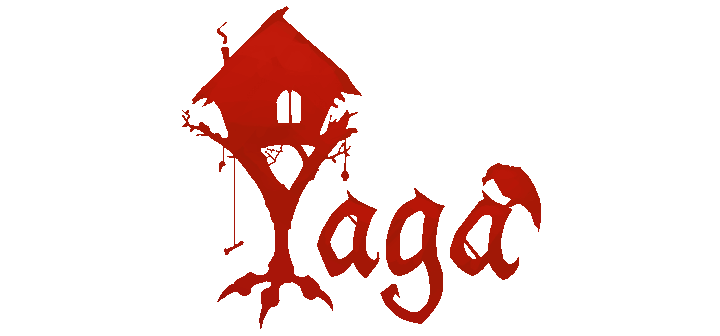Yaga is close to brilliance, thematically, but is missing one crucial step beyond the undemanding gameplay.
Type: Single-player
Genre: Action, Adventure
Action, Folktale, Mythology
Developer: Breadcrumbs Interactive
Publisher: Versus Evil
Release date: 12 November, 2019


Introduction
Yaga is an action adventure game that plays a bit like Bastion and hints at the structure of Sunless Sea.
The way is weaves slavic fairy tales into a playable story is almost brilliant, but the design seems stuck between a rogue-lite and a single-playthrough experience in a way that satisfies neither. The tools of a decent rogue-lite
are there, but the story was (surprisingly) static and the difficulty far too low to warrant multiple playthroughs, making it a rather short game at around 6 hours.
Why was I interested in Yaga?
This is a strange section in a review, but what follows depends heavily on my initial reasons to play here, so here we go. There were two reasons for my interest in Yaga:
(1) Convergent thinking. About a year ago, I was reading the 1001 Nights and felt like there was a game lurking under the surface. Particularly the use of the frame-story (stories inside stories) and the careful timing of each
story for Scheherazade to avoid an untimely death. I had some vague ideas about a narrative rogue-lite, but nothing very satisfying developed and I quickly abandoned the thought. Yaga seemed to have started the same idea and managed to develop it further, so I was very curious!
(2) I’ve recently become more interested in the oral tradition, both in the form of epics and folk-tales. In the case of the epics, particularly the idea that each telling is unique, almost improvised to suit the audience, sometimes
adding or removing episodes or descriptions in a way that shapes the structure of the stories themselves. Once again, Yaga seemed to run with that idea in a very interesting way.
In my view, after having played it, it seems that the game solved 80% of the problems I hadn’t solved in a satisfying way. Yet, surprisingly, they didn’t take the design further enough. The main ideas are all there, but they have
somehow not been implemented to their conclusion. I’ll get into it later, but let’s cover the more standard aspects of the game.
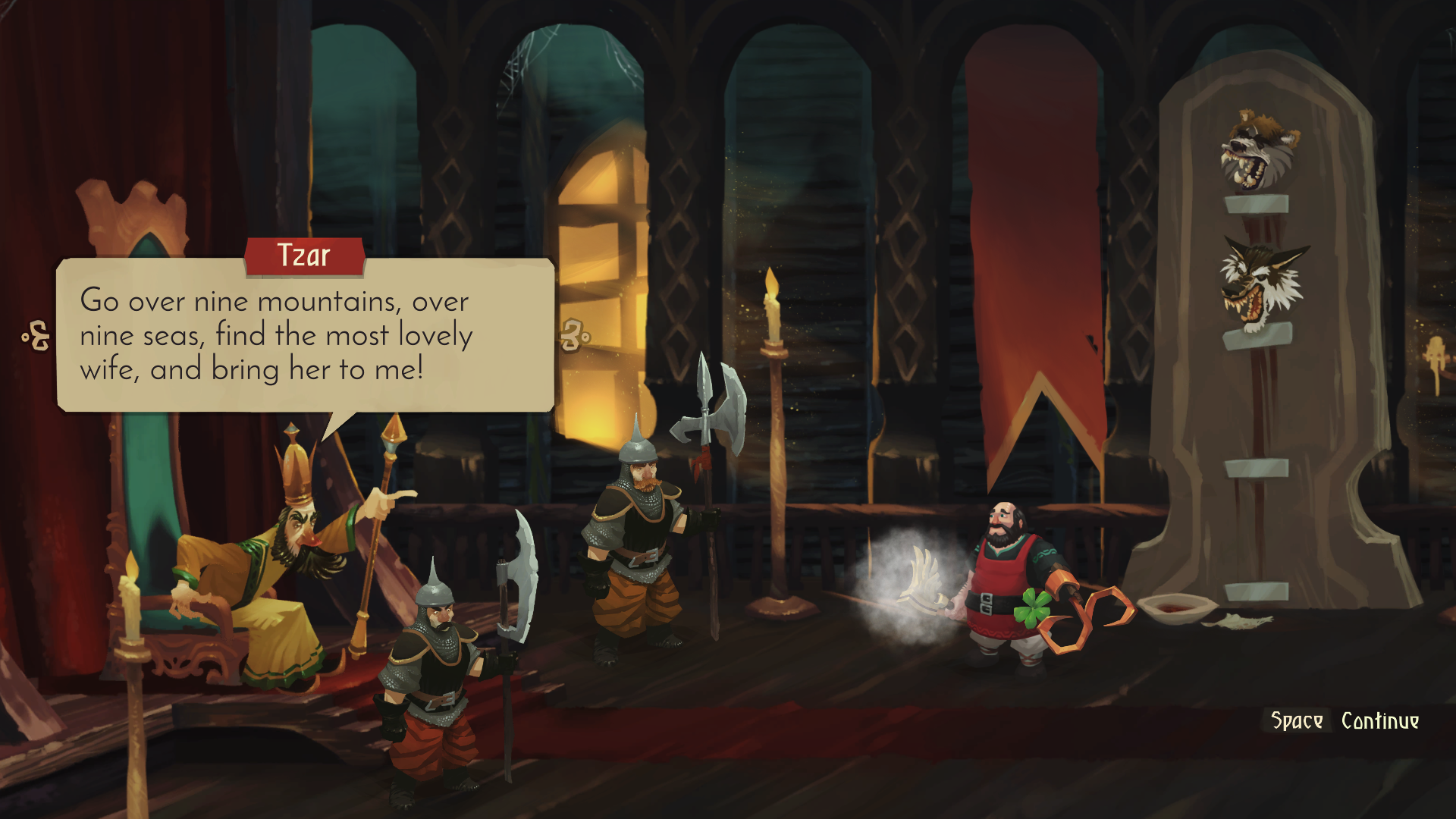
Graphics
Graphically, I feel like the game missed a good opportunity. The game doesn’t look bad at all, but it doesn’t look very unique. It has a fairly generic cartoony style that doesn’t suit games particularly well (perspective on the attacks and dodges can sometimes be a little iffy, as are the hitboxes – but isn’t very aggravating since the game doesn’t require precision anyway) and, above all else, doesn’t take advantage of the fairy-tale theme!
There are incredibly unique illustrators known for their fairy tales – the Swedish John Bauer is probably the best example, whose art inspired games like Child of Light and Oknytt; another example is Eyvind Earle, who worked on
some older Disney movies, and whose work also inspired The Banner Saga. When I looked into it, I quickly found Ivan Bilibin and Boris Zvorykin, each with their own distinctive style and a great fairy-tale style which would have
been a good fit for Yaga’s Slavic theme.
I feel like this is important, it’s a way of showing one side of a unique culture (or group of cultures, really), while still demanding skill and creativity in weaving the traditional aspects into an interactive game.
And they surely felt it too, because they absolutely nailed the music, in this respect.
Music
The music implementation isn’t particularly sophisticated, but it works well enough.
Where it’s brilliant is in its blending of new and old. It combines Romanian traditional music (with which I am not too familiar, beyond the Taraf de Haidouks band of gypsies) with a more modern electronic/hip-hop music and the result is really amazing! I am not a fan of hip-hop and yet I’m still listening to the artists whose music was used in this soundtrack – Subcarpati and Argatu’. I can sometimes be a bit of a purist, but I find their music really
fucking good, especially Argatu”s, who are more focused on the instrumental and traditional singing rather than the rapping. Either way, it’s really cool, and fits the theme perfectly!
It’s not entirely unlike Bastion, in its use of blues and electronic music, with sparing use of vocals. In fact, the music style was the aspect that first reminded me of the game, and only then did I realize the gameplay
similarity between the two games, which I’ll talk about next.
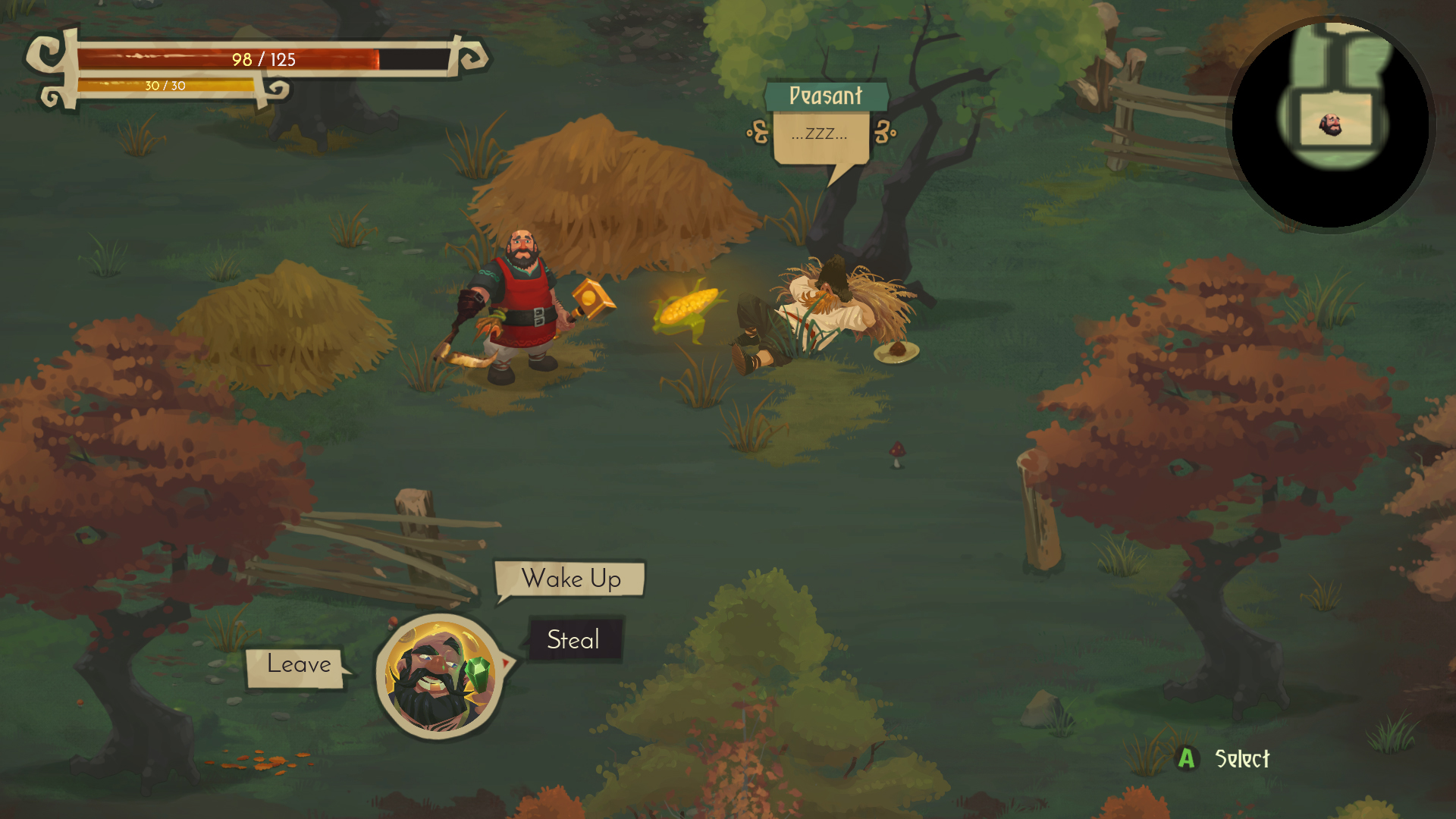
Gameplay
In Yaga, you control a one-handed blacksmith. You have a hammer you can bash or throw into enemies, and you have one of several auxiliary tools making up for your missing hand. These tools include a grappling hook, a bear paw that
knocks things away, a scythe that stuns enemies, and some other. Unfortunately, they have very little use in combat and have almost as little use outside the combat – they should have been used to unlock some paths to chests, but
there are very few of those anyway.
The game is played from a top-down perspective, more or less. You can also roll to avoid enemies. For the most part, you’ll be using your hammer as a ranged weapon since it is the most effective way of dealing with enemies. Each
hit staggers enemies, so you deals with both melee and ranged enemies while keeping you safe. Why aren’t the secondary tools useful?
Your character has 3 stats: willpower, stamina and fate. Only the first two are relevant, for now. Willpower is your HP, and stamina is both stamina and armor. If your willpower reaches 0, you die; your stamina regenerates if you neither roll nor attack for a few seconds. The thing about stamina is that it acts as a shield (while you have it), preventing HP loss when hit. However, it is also consumed when you use tools. Strangely enough, it isn’t consumed
when you’re attacking with the hammer, nor when rolling. This is one of the strangest design decisions they’ve made. In combat, using a tool becomes very similar to taking a hit, and so their use is extremely specific, limited to the situations where stunning an enemy could prevent more stamina depletion than using the tool – that’s very rare. As a result, for the most part, you’ll ignore the tools. That’s been my experience, anyway.
What is Fate about? Well, the game uses the concept of role-playing (as in actually playing a role — righteous, aggressive, greedy or idiotic — not RPG stats) and bad luck. Roles affect the result of interactions with NPCs (side-quests)and also what kinds of upgrades you get when you level up (more on that later). Over time, your character becomes “righteous” or “greedy”, and if you choose dialogue options inconsistent with your role, you get bad luck. Using magic items (consumables) also increases bad luck. Fate decreases your bad luck increase.
Bad luck is a strange mechanic, but I actually liked it – with a caveat. In a level, your bad luck gradually increases. If it reaches a certain threshold, a witch named Likho will steal your main weapon and maybe some equipment.
So you probably want to be careful, if you like your main weapon.
This is relevant because of the game’s main mechanic – crafting. It’s a simple mechanic, but with great potential – and still very fun in its current state. Basically, you will find various components throughout the game with which you can craft weapons. Once you’ve upgraded your anvil to the full, you will have one Ore and three Component slots. Each ore and component will add a different effect to your hammer. Some do more damage in general, some more damage to specific enemies, some add a poison effect, a stun effect, a chance to drop money, etc., etc. One of the most and overpowered made the hammer jump from enemy to enemy. With high enough damage, it would melt everything.
This is a very cool mechanic! It lets you adapt your hammer’s effects to your playstyle.
So why is losing it good? Well, it feels absolutely terrible! People value items they own more than items they do not (known as endowment effect), so this mechanic feels really terrible. However, you can manage it, if careful.
There is a magic item that removes all your bad luck, for example, and there are ways (quite simple, actually) to generate more than enough of them later in the game. Still, when you do lose your weapon, that’s actually a good
thing – because it gives you a reason to experiment with different combinations! Sure, you’ve hit a very good weapon, but then you’ll have to make due with whatever materials you currently have. And that can be a good way to explore the combinatorial space of weapons. It actually worked for me, so I was able to overcome the terrible feeling and enjoy the mechanic for what it was. It also had some thematic value, which is important in a game like Yaga.
There are many small mechanics like consumables, equipment, blessings, curses, perks, body parts as magical currency, money as normal currency, etc.; I won’t get into those in much detail. They function almost like the many mini-mechanics in a rogue-lite like the Binding of Isaac. And they would have been great! The problem, however, is that the game isn’t really designed in a way that takes advantage of all of them. It lacks the structure and the depth and, in the end, these mechanics don’t matter much.

Structure – not quite a rogue-lite
I’m becoming a caricature, at this point. I’ve argued that ARPGs like Diablo should be rogue-lites. Now I’m arguing that Yaga should be a rogue-lite. Every game should be a rogue-lite! Right? Not at all. But it is a very popular genre, and one that has seen incredible development in this decade. It’s also incredibly influential, and you often see games using mechanics out of context which doesn’t really work out in the end.
I’ll talk about the game mechanics, here, and how the narrative fits into all of it next. I will also be comparing it with Bastion, since I’ve played it right after this one and it confirmed my thoughts to a much larger extent than I expected – Bastion’s gameplay was not what made it memorable, to me.
Yaga’s levels are procedurally generated. Levels are a collection of rooms with 4 possible cardinal connections. Obstacles come from a pool and enemies seem to spawn more or less randomly. These levels have “special rooms” throughout. Some are Altars to the Slavic Gods, where you can Pray, Clean (sometimes this means stealing offerings), Offer something, or leave them alone, for different outcomes depending on the action and the God, but typically giving you an item of some kind. There are also mini-quests. These are great! They are like miniature folk-tales, well written and often genuinely funny.
Another very important aspect that pushes it into rogue-lite territory is how everything is random to some degree. When you level up, you get one upgrade out of the three presented, which are random, and based on your “roles”.
When you get to town, there is also a merchant with three random items for sale. Before you start a level, you can also choose the “time of day”, which grants you a different perk for that level – whether faster attacks, weaker enemies, less bad luck, etc.; there is also a crow which takes 100 gold or 10 body parts to give you a random item on the next level.
With this, I hope you can see why I consider Yaga to be almost a rogue-lite. Most of the mechanics are there. You can choose to explore more or less of each level to get more money, body parts, XP, items, etc., at the risk of losing some of it by accumulating too much bad luck.
The last aspect that supports the rogue-lite theory is how opaque every mechanic is. Nothing is explained. For example, I never realized that the choice of upgrades on level-up was determined by your “roles”. I went to their Discord after finishing the game and asked a few questions about the mechanics. Similarly, I never knew Fate decreased bad luck, although I had a feeling due to the interface colors. You can also donate to the church in town, which I still don’t know why you would. Maybe their blessings become cheaper? Better? I don’t know.
Opaqueness itself isn’t good or bad. But it means you need to provide the player with enough learning opportunities.
There are two main design aspects where Yaga fails.
First, replayability. The game is 5 or 6 hours long, at most. And replayability is very limited, partly because of the difficulty, partly because the story is fixed. So you don’t really get to play around with all of the obscure mechanics to learn what they do. In Binding of Isaac, you play the same levels over and over again. You can beat the game in less than an hour if you’re good, but beyond that, early runs should take between one and two hours, and the game unlocks more content once you beat it once, so the replayability is built into it in a way that justifies the obscure mechanics.
This lack of replayability also means you don’t get to try nearly every cool hammer combination, either! The designers built the combinatorial complexity into the game, but not the structure to take advantage of itself.
Second, the difficult. The game is far, far too easy. I “died” once, but didn’t actually fail the level, because I had one resurrection item. That was pretty early on. Later, I almost died another time, because I let myself be cornered by the item and almost didn’t get out. I barely needed to use “bread” to get my HP up, except in some bossfights where I played carelessly. I didn’t use any magic items at all, beyond the item that lowered bad luck. Halfway through, I could buy every merchant item and still had more money than I could use. This creates two problems: (1) if there is no danger, there is little reason to change strategy, try all the mechanics, etc.;
and (2) there is little reason to replay the game.
Ok, where does Bastion come in? It’s fairly similar in the most basic gameplay (although its weapons build a lot more complexity into it), but it has a much better structure for a single-playthrough. First, the game is generally more difficult. But more important, it has the option of demanding more of the player: you have a challenge stage for each weapon, with 3 mastery levels; you have difficulty modifiers that reward you with more XP; you have survival stages to get more XP and combat practice; and it has a deep enough upgrade system to justify pushing yourself to attempt all these extras.
Yaga, instead, is an extremely easy game form the start, and even lets you grind more in the late game if you want (by offering the option of replaying some zone and “slay monsters” before moving on with the story).
Finally, the reason why I felt like writing about all of this is that the Yaga has already solved the narrative problem of the rogue-lite! At least in concept and potential, if not in content and implementation.
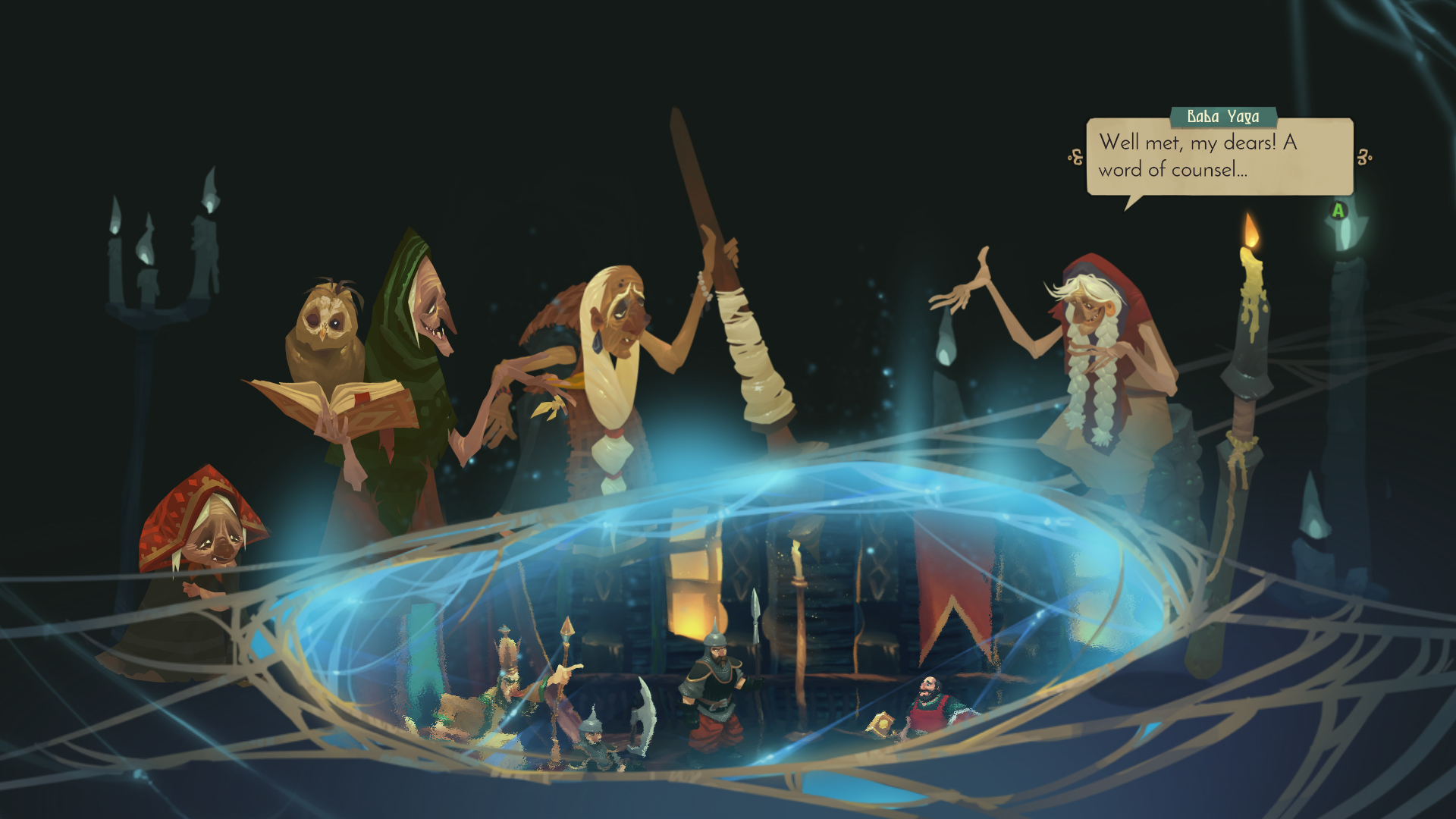
Yaga and the Oral Tradition
Yaga and the Oral Tradition
We live in a very literate culture and are used to viewing what’s written as “sacred”, mostly because we can always go back and check it. It’s much closer to the “truth” as we can get, assuming there aren’t copying errors.
Whenever people talk and remember, however, you can expect change and illusions. This affects the way we view stories just as much. We look for the “canonical” story in everything (Homer’s epics were likely just one performance, and not in any way special that justifies its lone survival into today – you still have long sung epics, improvised, in the Balkans and all over Central Asia).
But the oral tradition doesn’t work like that. From folk tales to epics, you will find many variations of the same story, and many common motifs, themes and narrative devices. In Yaga, you are a blacksmith who has bad luck, and the Tsar gives you three challenges with the intention that they will kill you and rid the kingdom of you. You will look for the old witch Baba Yaga to help you in your quest. You will look for the Golden Apple of Strength,the Water of Youth, and try to find a bride for the Tsar. You will have to fight Koschei the Immortal. All of these are very common across Russian folk-tales.
The larger folk-tales, the kind into which the game fits, also use the idea of a “frame-story” – an overarching narrative into which you can fits other smaller stories or pieces of stories. The most aberrant example of this
is the 1001 Nights, where you have stories inside stories inside stories inside stories (and it may go deeper down). But Slavic folk tales also use it, if to a smaller extent, and at many different levels. The three challenges of the Tsar are one example – these challenges aren’t fixed and can be used to introduce another adventure.
Vladimir Propp was particularly influential in folklore studies for his systematization of Russian folktales. Essentially, he analyzed the structure and motifs of the stories and showed how they can be combined in many different ways to construct a full tale.
Why am I writing about all this? Because this is exactly what Yaga should use! And it almost does.
As I said, the Tsar’s challenges are one kind of frame story. And maybe this should be fixed because of how it fits with the blacksmith setting, the bad luck, and so on. But there are many things that should vary from there.
The several “side-quests” you encounter, in the town or in the levels, are entirely unrelated to the plot. They could be replaced with many other stories.
And this is what I don’t understand. I tried to “change tale” (the actual option on the menu) after I had finished the game but the result was exactly the same! Every quest on the town was the same, the (otherwise arbitrary) items to offer to Yaga were the same, even the “side-quest” on the first level was the same.
The game seemed like the perfect engine to generate folk-tales, but then they used the engine to create a single canonical story. And the game is much poorer as a result. They have solved all the problems, but somehow didn’t take the final step. I can’t understand why and it bothers me, haha! Perhaps this has to do with pressure to release the game on a deadline, I don’t know.
But I found it really interesting to play the game and see how it had all the components to make a great replayable game out of them — both mechanically and narratively — but then the developers became shy and went with the more generic single story that just squandered tons of potential that seem right there for the taking!
That covers just about all I wanted to say about the game. I will make two minor points and then wrap-up.
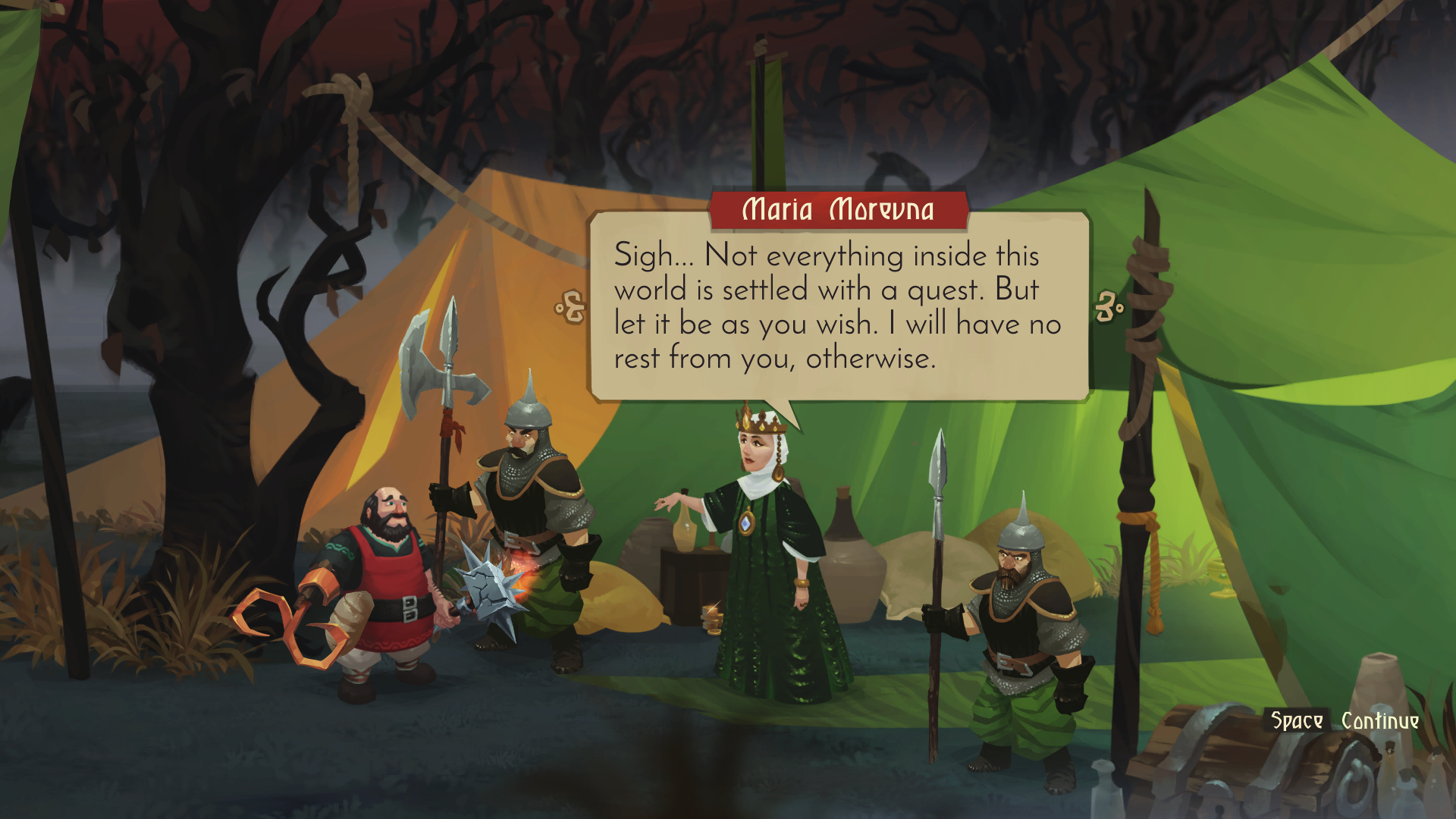
Role playing
As I mentioned, the game has a role-playing system. You can choose to be righteous, greedy, idiotic or aggressive. There is one big problem there, however, and that is that every dialogue response tells you what “role” you’re playing. Even when it seems to contradict its content. Furthermore, the role gives you a kind of magical insight – if you follow the righteous responses blindly, you will never be fooled by a demon, for example. But shouldn’t you be fooled by the demon? Shouldn’t you rely on your own perception to figure out whether you’re being tricked?
The result is that you don’t need to think about the situations and responses at all – all you need is to look at the icon and choose whichever you want, mechanically.
I think this really hurts the game and teaches the player very little about the culture. At no point do you need to pay attention, and that’s a bummer.
Epic store timed exclusive
This is a weird section for me, but I actually find it important, in this case.
I don’t really care about all the drama about the Epic Store. I’m happy to get the free games and don’t find their launcher to be very troublesome. Sure, their tactics are aggressive, but I’m not too preoccupied with that.
That said, I feel like this choice hurt Yaga by reducing the player base and because of the lack of a canonical forum. This is important, again, because of the opaque mechanics. In Steam, you can go to the Community Hub and you’re likely to find other people with questions, or to answer yours. That is especially important for small and new games, where you’re unlikely to have a wiki, and where most players have only partial knowledge of the mechanics – so your question isn’t a direct spoiler, but a kind of pooling of everyone’s knowledge to figure the game out.
Because the Epic Launcher lacks forums, there isn’t really a single place where players will go. I went to their Discord, but the answers I got were only from the developer, and there was very little player activity (which is also lost in a single long thread rather smaller focused posts).
So take this into account. Perhaps it will be better to wait for the Steam release if you like to get into forum discussions.
Conclusion
I enjoyed Yaga. I found it a very interesting game to think about, but less so to play.
The design is undecided, unsure of whether it should be a replayable rogue-lite or a plot-focused single playthrough game. It has parts of which, but fails to take advantage of the best of either.
The difficulty is too undemanding, largely reducing the combinatorial power of the mechanics. Combined with the lack of story variation, it severely limits replayability.
The level design is procedural and modular, lacking the focused challenge and setup that a single playthrough game should provide, and the story is just one out of many possible fairy tales.
If you’re intrigued by the concept, by all means, give it a shot. It’s a short game that will entertain for a few hours.
If you want something to really sink your teeth into, looks elsewhere.
If nothing else, I would be really excited to see Yaga’s ideas taken to their logical conclusion with added content and design.

